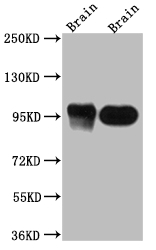To produce the DLG4 recombinant monoclonal antibody, the DLG4 monoclonal antibody is harvested, and its gene is sequenced. A DLG4 monoclonal antibody gene-carrying vector is then constructed and transfected into a host cell line for culture. The human DLG4-derived peptide is utilized as an immunogen to produce the DLG4 monoclonal antibody. The DLG4 recombinant monoclonal antibody is subjected to affinity chromatography purification following isolating from the cell culture supernatant and then tested for specificity using ELISA and WB applications. It can detect human, mouse, and rat DLG4 proteins.
The DLG4 protein, also known as PSD-95, is a scaffolding protein that plays a critical role in the organization and stabilization of synapses in the nervous system. It is involved in the regulation of synaptic strength and control of synaptic plasticity, as well as the maintenance of neuronal structure and function. DLG4 interacts with proteins involved in cytoskeletal organization and helps to maintain the integrity of dendritic spines, which are important for synaptic fu Dysregulation of DLG4 activity has been implicated in various neurological disorders, including schizophrenia, autism, and Alzheimer's disease.






